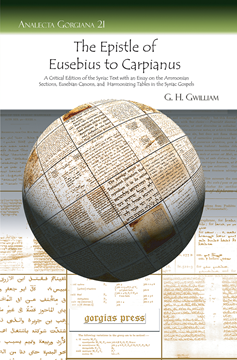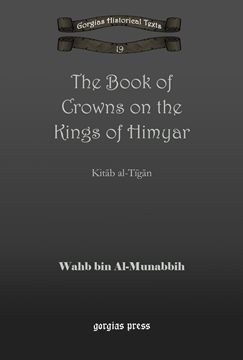The Books of the Bible and the Writings of Cyprian in the Phillipps Collection at Cheltenham
With a Stichometry by C. H. Turner
By W. Sanday
Series: Analecta Gorgiana 16
ISBN: 978-1-59333-494-9
The remarkable discovery of a fourth-century list of the books of the Old and New Testaments and the writings of Cyprian is related in this essay. The canon and order of the biblical books are discussed and the stichometry of the lists is also explored.
$90.00 (USD) $54.00 (USD)
The Authorship and the Titles of the Psalms According to Early Jewish Authorities
By Ad Neubauer
Series: Analecta Gorgiana 17
ISBN: 978-1-59333-495-6
Neubauer addresses the related issues of the authorship of the Psalms and the individual psalm titles according to the early Jewish authorities. Beginning with a survey of what is known about music usage in Israelite worship, Neubauer launches into a thorough examination of what the Rabbinic material preserves regarding these issues.
$46.00 (USD) $27.60 (USD)
The Origin and Mutual Relation of the Synoptic Gospels
By F. H. Woods
Series: Analecta Gorgiana 18
ISBN: 1-59333-496-6
The vexing question called the Synoptic Problem has long interested New Testament scholars. Woods weighs in on this question providing evidence for Mark’s priority based on the use of language in the Gospels.
$43.00 (USD) $25.80 (USD)
The Day and Year of Saint Polycarp’s Martyrdom
By C. H. Turner
Series: Analecta Gorgiana 19
ISBN: 1-59333-497-4
Among the most important chronological questions of Christianity in the second century is the date of St. Polycarp’s martyrdom. Turner scours the evidence to determine a precise date, based on comparison between the Roman and Asiatic calendars and other historical references. This dating in turn helps to date Irenaeus and St. John.
$44.00 (USD) $26.40 (USD)
Codex Amiatinus of the Latin Vulgate Bible and Its Birthplace
By H. J. White
Series: Analecta Gorgiana 20
ISBN: 1-59333-498-2
White takes the reader through a historical puzzle revolving around the date of the Vulgate manuscript Codex Amiatinus. He demonstrates that the manuscript falls in the eighth century and traces its origins to Italy.
$44.00 (USD) $26.40 (USD)
The Epistle of Eusebius to Carpianus
A Critical Edition of the Syriac Text with an Essay on the Ammonian Sections, Eusebian Canons, and Harmonizing Tables in the Syriac Gospels
Series: Analecta Gorgiana 21
ISBN: 1-59333-499-0
Gwilliam presents a critical edition of the letter of Eusebius to Carpianus, as well as a Latin translation. Essays concerning this important epistle addressing the harmonization of the Gospels provides a valuable early insight into the Synoptic Problem.
$45.00 (USD) $27.00 (USD)
Ancient Liturgies of the East
Series: Kiraz Theological Archive 13
ISBN: 1-59333-501-6
Bringing together into one volume the classic liturgical studies of C. E. Hammond and F. E. Brightman, this edition provides a valuable source of comparison on the liturgies of the church. Included in this edition are the complete text of Hammond’s “Antient Liturgies” and Brightman’s “Eastern Liturgies” from his two volume set “Liturgies Eastern and Western.”
$374.00 (USD) $224.40 (USD)
Acts of Saint George
By E. W. Brooks
Series: Analecta Gorgiana 8
ISBN: 1-59333-485-0
The classic hagiography of Saint George is presented here by E. W. Brooks. He gives a critical edition of the Syriac accompanied by an annotated English translation of the Acts. The “Acts of Saint George” stands in the tradition of early Christian devotional and historical records, and is a standard source for information about this formative saint.
$43.00 (USD) $25.80 (USD)
S. Ephraemi Syri, Rabulae Episcopi Edesseni, Balaei, Aliorumque Opera Selecta
Selected Works of St. Ephraem the Syrian, Rabbula, Bishop of Edessa, and Balai
ISBN: 978-1-59333-517-5
A useful source for Syrian documents generally hard to find, this compendium of the writings of St. Ephraem the Syrian, Rabbula, Bishop of Edessa, and Balai, the hymnographer, is a necessary addition to any Syriac scholar’s library. Presented in Syriac, they are available now as a handy resource.
$206.00 (USD) $123.60 (USD)
The Book of Crowns on the Kings of Himyar
Kitāb al-Tīgān
Series: Kiraz Chronicles Archive 19
ISBN: 978-1-59333-515-1
The Book of Crowns on the Kings of Himyar, or Kitāb al-Tīgān as it is known in its original Arabic title, is a pre-Islamic collection rich with lore and myth by Wahb ibn al-Munabbih.
$130.00 (USD) $78.00 (USD)








